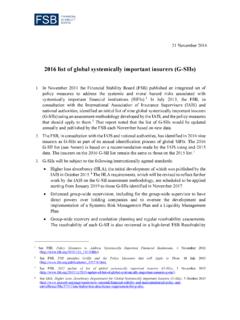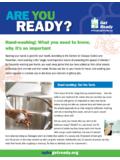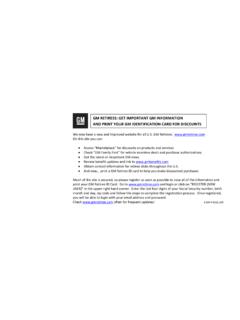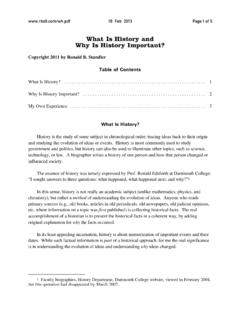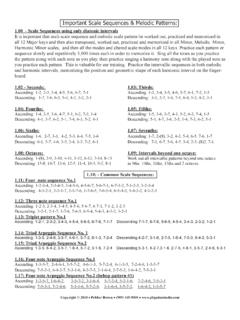Transcription of Debriefing: The Most Important Component in Simulation?
1 ~~--~~-- --- - -- -----~--- Clinical Simulation in Nursing (2011) 7, el05-elll ELSEVIER Featured Article Clinical Simulation in Nursing <Hn/lncate/cc,"l debriefing : The most Important Component in Simulation? Mary Ann Shinnick, PhD, ACNP-BC, CCNSa, Mary Woo, DNScb, Tamara B. Horwich, MD, MSc, Randolph Steadman, MOd "School of Nursing, UCLA Health System Patient Safety Institute, University of California at Los Angeles, Los Angeles, CA 90024, USA "School of Nursing, University of California at Los Angeles, Los Angeles, CA 90095, USA 'Ahmanson-UCLA Cardiomyopathy Center, Los Angeles, CA 90095, USA "UCLA School of Medicine, Los Angeles, CA 90095, USA Abstract Background: Simulation is a time-and cost-intensive teaching modality that consiists of both hands-on experience with a lifelike manikin and a debriefing session. While many educators believe that both sim-ulation components are Important for learning, the impact of the individual components is unknown.
2 Objectives: The purpose of this study was to determine where in a simulation experience greater knowl-edge gains occurred. Methods: With a 2-group, repeated measures, experimental design, this study examined the impact of sim-ulation components (hands-on alone and hands-on plus debriefing ) on heart failure (HF) clinical knowledge in 162 prelicensure nursing students (age: M = years, SD = years; women) from 3 nursing schools who were at the same point in their curriculum. Parallel HF knowledge tests were given at baseline (Pretest) and after the hands-on (Posttest 1) and debriefing (Posttest 2) stages of the HF simulation. Results: HF knowledge scores decreased from the pretest to the first posttest (after the hands-on compo-nent of the simulation; M = , SD = ; p < .001), whereas they dramatically improved after debrief-ing (M = + , SD = ; p = < .001). Conclusion: Gains in HF knowledge were achieved only after debriefing . This study suggests that the de-briefing experience should be emphasized in a standardized simulation learning experience.
3 Further inves-tigation is needed to evaluate the impact of debriefing and intensive teaching without the hands-on simulation Component . Cite this article: Shinnick, M. A., Woo, M., Horwich, T. B., & Steadman, R. (2011, May). debriefing : The most Important Component in simulation? Clinical Simulation in Nursing, 7(3), e105-e111. 2011 International Nursing Association for Clinical Simulation and Learning. Published by Elsevier Inc. All rights reserved. Corresponding author: (M. A. Shinnick). 1876-1399/$-see front matter 2011 International Nursing Association for Clinical Simulation and Learning. Published by Elsevier Inc. All rights reserved. Background High-fidelity simulation (HFS) is a time-and cost-intensive teaching modality that consists of both hands-on experience with a lifelike manikin and a debriefing session. The hands-Key Points Many educators be-lieve both simulation components are im-portant for learning. Previous studies have not evaluated the im-pact of the HFS com-ponents individually.
4 Faculty should be ade-quate! y prepared in de-briefing as it is a vital Component of the sim-ulation experience. on experience often consists of a mock clinical event. debriefing , also referred to as guided reflection, is a planned session after the simulation and is led by the instructor, who provides students with the time to as-sess their decisions, actions, communication, and ability to deal with the unexpected (Decker, 2007). Although there are several models of debriefing techniques (Decker, 2007; Dismukes, Gaba, & Howard, 2006; Fanning & Gaba, 2007; Rudolph, Simon, Dufresne, & Raemer, 2006), debriefing is generally considered to be a time for the participant to reflect on the event, discuss it with others, learn, and modify behav-ior as a result (Decker, 2007; Fanning & Gaba, 2007). While many educators believe that both simulation com-ponents are Important for learning (Decker, Sportsman, Puetz, & Billings, 2008; Kardong-Edgren, Lungstrom, & Bendel, 2009; Thompson & Bonne!)
5 , 2008), others believe debriefing to be essential to the learning process (Fanning & Gaba, 2007; Rudolph et a!., 2006; Shinnick, 2010; Shinnick & Woo, 2010a, 2010b; Shinnick, Woo, & Evangelista, 2010; Smith, Jacob, Segura, Dilger, & Torsher, 2008). However, the impact of the individual components has not been established. The contribution of these simulation components on gains in clinical knowledge is uncertain because previous studies of prelicensure nursing students and HFS have not evaluated the impact of the HFS components individually. most studies have evaluated the influence of the entire HFS experience, and these studies have concentrated on descriptive and subjective outcomes, with little objective evaluation of gains in knowledge. However, both faculty and professional nursing organizations (American Association of Colleges of Nursing, 2008) emphasize clin-ical knowledge gains in students. Although such knowledge gains with HFS have been demonstrated in basic and advanced life support training (Monsieurs, De Regge, Vogels, & Calle, 2005; Palmisano, Akingbola, Moler, & Custer, 1994; Verplancke, et a!
6 , 2008), increases in other forms of clinical knowledge have rarely been reported. A review of the nursing simulation literature reveals a paucity of research on knowledge acquisition in student nurses. A published, quantitative literature review by Ravert (2002) revealed a positive effect on knowledge and skill e106 acquisition from simulation in 76% of the cases she reviewed, but none of these were done on pre licensure nursing students. Of the few published studies to examine HFS and knowledge in prelicensure nursing students, Alinier, Hunt, Gordon, and Colin (2006) found knowledge gains higher in the simulation group using an objective structured clinical examination, while Hoffman, O'Donnell, and Kim (2007) used a one-group re-peated measures design and found the Basic Knowledge As-sessment Toll-6 (BKAT) scores to be significantly higher (p < .05) in six subscale areas after simulation. Jeffries and Rizzolo (2006), in a large national study, found no significant knowledge gains between first exposure to high-fidelity mani-kin simulation, static manikin, and paper-and-pencil case study on a two-item National Council of Licensure Exam (NCLEX) -type test.
7 Kardong-Edgren et al. (2009) found significant in-creases in knowledge immediately after an HFS exposure but significant decreases in knowledge 6 months later (Kardong-Edgren, et a!., 2009). Despite these conflicting reports of knowledge increases in prelicensure students, there was no identification of where in the simulation experience the greatest gains occurred (Alinier et al., 2006; Hoffmann et al., 2007; Jeffries & Rizzolo, 2006; Kardong-Edgren et al., 2009). Regardless of the lack of research in this area, there is a widespread desire to incorporate simulation into nursing curricula (Bandali, Parker, Mummery, & Preece, 2008; Seibert, Guthrie, & Adamo, 2004; Wilford & Doyle, 2006). Both edu-cators and clinicians should take this issue seriously because the commitment to incorporating HFS into nursing education is not only a financial one but a time-and resource-intensive one as well (King, Moseley, Hindenlang, & Kuritz, 2008). Advancement in simulation technology use has exceeded the evidence of its value in prelicensure nursing education although emerging research is building evidence in its support (Lapkin, Levett-Janes, Bell chambers, & Fernandez.)
8 20 I 0). Knowledge of its effectiveness and its greatest impact on knowledge should guide and influence its use. As acquisition of knowledge is fundamental in nursing education, this study sought to examine the impact of the simulation components (hands-on alone vs. hands-on plus debriefing ) on clinical heart failure (HF) knowledge in prelicensure nursing students. Specific Aims The specific aims of this study were (a) to determine whether HFS of a common adult clinical situation, HF, improves the HF knowledge of prelicensure nursing students and (b) to determine where in the process of HFS (hands-on alone vs. hands-on plus debriefing ) knowledge is gained. Method Study Design This study used a two-group, repeated measures, experi-mental design (Figure 1). pp e1 05-e111 Clinical Simulation in Nursing Volume 7 Issue 3 Sample For the study a convenience sample of four cohorts of prelicensure nursing students (N = 162) was recruited from three schools of nursing.
9 All schools used the same simulation equipment (SimMan , Laerdal Medical, Wappinger Falls, NY). Institutional review board (IRB) approval was obtained from all three schools prior to the study. A power analysis indi-cated that a sample size of 128 participants would allow detec-tion of moderate ( ) effect sizes on a paired t test at a p value of .05 and power of Inclusion criteria were prelicensure nursing students in the same course at each school who had suc-cessfully completed instruction in care of HF patients. This point in the prelicensure curriculum is the standard equivalent of a medical-surgical course, Level III (or advanced medical-surgical course), traditionally taken in the 3rd year of a 4-year nursing program. Exclusion criteria were students who either had heart failure or had family members with heart failure. Stu-dents were randomly assigned by blocks (all students at that school for the day were assigned to the same group) to experi-mental (participated in HFS prior to Posttest 1) or control (no HFS prior to Posttest I) groups.
10 Both groups received hands-on HFS and debriefing prior to Posttest 2. Scenario Development The clinical situation of acute decompensated HF was chosen to be the focus of the simulation. Simulation of HF patients in the education of nurses in acute care is Important because HF is the most common hospital discharge di-agnosis in the United States in patients 65 years old and older (Schocken et a!., 2008) . In addition, in the United States there are more than 6 million Americans with HF, and more than 550,000 are newly diagnosed each year (Schocken et a!., 2008). Thus, HF patients can be found in many hospital medical units. Simulating different scenar-ios for HF patients is an Important Component in the clini-cal training of nurses at all levels. Three simulation scenarios of a clinical case of acute decompensated HF were created. They were identical to each other in design, with the exception of the patient history and gender. Parallel simulations were developed in order to decrease scenario predictability and cross talk between groups.


